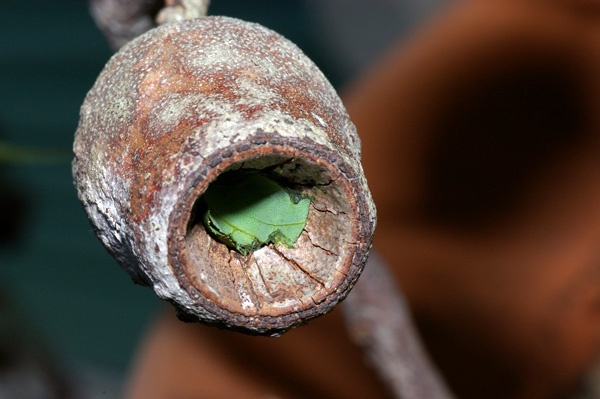Dear Kirsty,
Thank you for sending your images into Discovery Centre at
Melbourne Museum.
The Curator has said that he believes your specimen is Megachile
ferox, one of the leaf cutter bees.
Kind Regards, Simon.
Thankyou Simon. You have no idea how it pleases me to be able to give it a name. I have watched its daily flight, admired its fuzzy orange bottom and fluffy forehead, but without it's name it as if I have not truly known it. I am a huge fan of the author Ursula LeGuin, this is a quote from the Wizard of Earthsea as she describes the study of wizardry (well before Harry Potter):
"Ged sighed sometimes, but he did not complain. He saw in this dusty and fathomless matter of learning the true name of each place, thing, and being, the power he wanted lay like a jewel at the bottom of a dry well. For magic consists in this, the true naming of a thing".
What a fine, grand sounding name, Megachiles ferox. I love Latin names, the lolloping way they roll off the tongue, and the truth they hold within them. Chiles comes from the Greek word cheilos, meaning lip or edge. Perhaps referring to its leaf cutting ways. Ferox is latin for fierce, wild. Fierce seems a strange description, as this has been a tame bee, never bothered by our watchful eyes, gloriously fluffy, it apparently only has a mild sting if handled. I wondered what prompted the scientist who discovered it to use ferox.
The common name, Leaf Cutter Bee, is apt. Look below to see what they can do to a leaf. I will now be hunting my garden for signs of these distinctive perfect semi circle cuts, and I can give their creator a name. Leaf Cutter Bees are solitary, the female uses these leaves to build a cigar like nest that she places a single egg inside. The nests are hidden inside rotting wood, crevices and hollow twigs and stems. Such different behaviour to that of the honey bee.


Leaf cutter bees also have a reputation for being great pollinators and are used by farmers to increase yields of lucerne and alfalfa.
Now I know you a little more, I am even more enchanted, Megachiles ferox. I'm even tempted to build you a nest box.
Look how one is using this gum nut, shows the importance of being a bit messy in the garden, to leave nooks and crannies for all the critters.



That is so interesting, I love reading your posts on little critters! I had not heard of Ursula LeGuin until I saw the movie The Jane Austen Book Club. The character Grigg played by Hugh Dancy is a fan of her work.
ReplyDeleteooh, now I want to see the movie!
DeleteWow...how interesting...and so proactive of you to seek the info!!! love that gorgeous pic too!
ReplyDeleteThanks Jode, not knowing with plants and animals is like an unscratched itch for me.
DeleteThat is a great service, I love the museum even more knowing they give out such fab information.
ReplyDeleteI have seen small native bees in my garden but being allergic to them I stay well clear of them. I am interested in them, both my father and brother have hives and we enjoy their honey. I didn't know of this particular type, a solitary one i thought they would all live in hives..........you learn something new everyday.........thanks.
ReplyDelete